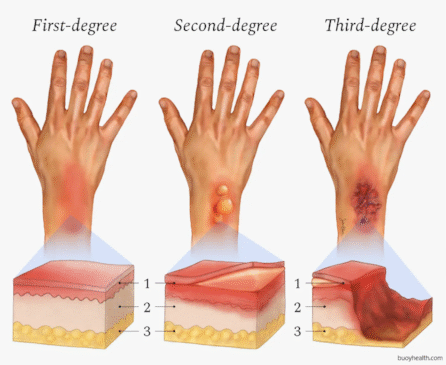The first week of February is designated as National Burn Awareness Week. This week is one in which multiple organizations around the country raise awareness of burn hazards and prevention techniques for Americans at home, at work, and at play. According to statistics from the CDC, nearly 75% of all burns occur in the home, while less than 10% happen in the work environment. But with nearly 450,000 burns requiring medical treatment annually, these numbers are significant for the victims and their families. This article will outline various types of burn injuries and how to best prevent burns in the work environment by identifying where the risks occur, and how to control them.
Burns are classified by the degree of damage caused to the skin. A first-degree burn shows superficial damage to the outer layer of skin with minimal damage. This is shown with a discoloration and felt with a slight amount of pain to the touch. First-degree burns are the most common and typically are treated with basic first aid without requiring further medical treatment. First aid kits meeting ANSI Z308.1 will include burn treatment methods including gels and at least one dressing. Second-degree burns are those that go further than the top layer of skin and result in blisters and swelling. These burns are treatable without but may still need medical treatment. In most cases, second-degree burns occurring at work should be treated at a non-emergency medical facility to ensure no further damage has occurred. Third-degree burns are those that destroy the skin and underlying tissue, resulting in permanent damage and serous medical treatment. These burns should be considered a medical emergency and require immediate treatment.

Burn causes can also take multiple forms including thermal burns from hot surfaces, the most common and obvious of the hazard sources. Chemical burns occur when specific products such as corrosives come into contact with the skin. This commonly occurs with cleaning products or chemicals which employees may not be familiar with the hazards such as specific manufacturing materials such as concrete or coating materials. Electrical burns are common when contact with live electrical equipment takes place either through the nature of the work or by accidental contact with improper installation or damaged conductors. Thermal burns are also common when contacting surfaces heated by electrical sources. Lastly the sun is the cause of burn injuries for those employees required to work outdoors in the summer months. These burns are typically less severe but can result in damage to the skin and repeated exposures can lead to long term damage such as skin cancer.
Burns in the work environment are the most common in restaurant settings where cooking or working with hot surfaces is common. These occur when handling hot materials, liquids, and surfaces. Because of the nature of the work, this accounts for a substantial portion of the occupational related burns. These hazards are more difficult to control in these types of work environments, mostly because of how common the exposures occur. Typically, only a basic safety training is offered to these employees to prevent burns. Speaking from roughly 10 years of personal experience, the training offered is rudimentary and more reliant on common sense than employer efforts. However, this is not always the case and many organizations have improved their methods to reduce the overall number of workplace injuries. These include avoiding overcrowding items on cooking surfaces, facing handles away from the edges of the surfaces and limiting burner flames to the size of the pot or pan being used. Overall, training employees and staff of where these hazards are and using mitts and other devices to protect hands has the greatest impact on reduction. The biggest efforts are usually in preventing chemical burns by providing training on materials handling and dangers of specific products.
In other work environments, the hazards may not be as clear or obvious. Industrial plants, manufacturing facilities, and construction projects utilize manty types of heat producing processes and hazardous chemicals. Welding and other types of hot work by their nature use large amounts of heat to complete the task. Training processes are required for personal protective equipment and how to conduct the work to limit fires and prevent accidental contact. Most aspects of hot work require heavy leather PPE and the presence of a fire extinguisher in the work area. Chemical burn prevention also requires the use of chemical resistant PPE and safety splash goggles or face shields. Ensuring employees are familiar with the hazards of the chemicals in use and how to prevent splashing and sprays are the best prevention techniques available. Eye/face/body wash stations are required when using corrosive chemicals which could result in these types of burns to remove the materials a soon after contact takes place. Lastly, electrical burns are preventable through the same PPE and training techniques, but also through control of work activity. Working with live electrical equipment requires qualified personnel and a thorough knowledge of the NFPA 70E standards which govern live electrical work with processes to first minimize the exposures to live electrical hazards and PPE requirements when no other alternative methods exist.
Overall, burns account for a significant number of workplace injuries, which are all preventable through employee training and a thorough identification of the hazards. These injuries can lead to life changing injuries and potentially even fatal accidents. Employers are best suited to follow hazard identification techniques, train employees, and provide them with required PPE to allow them to perform the task, with the risks of injury.
Related Topics: Safety Resources News, Home Safety, Safety Awareness, Monthly Safety Topics, Safety Articles